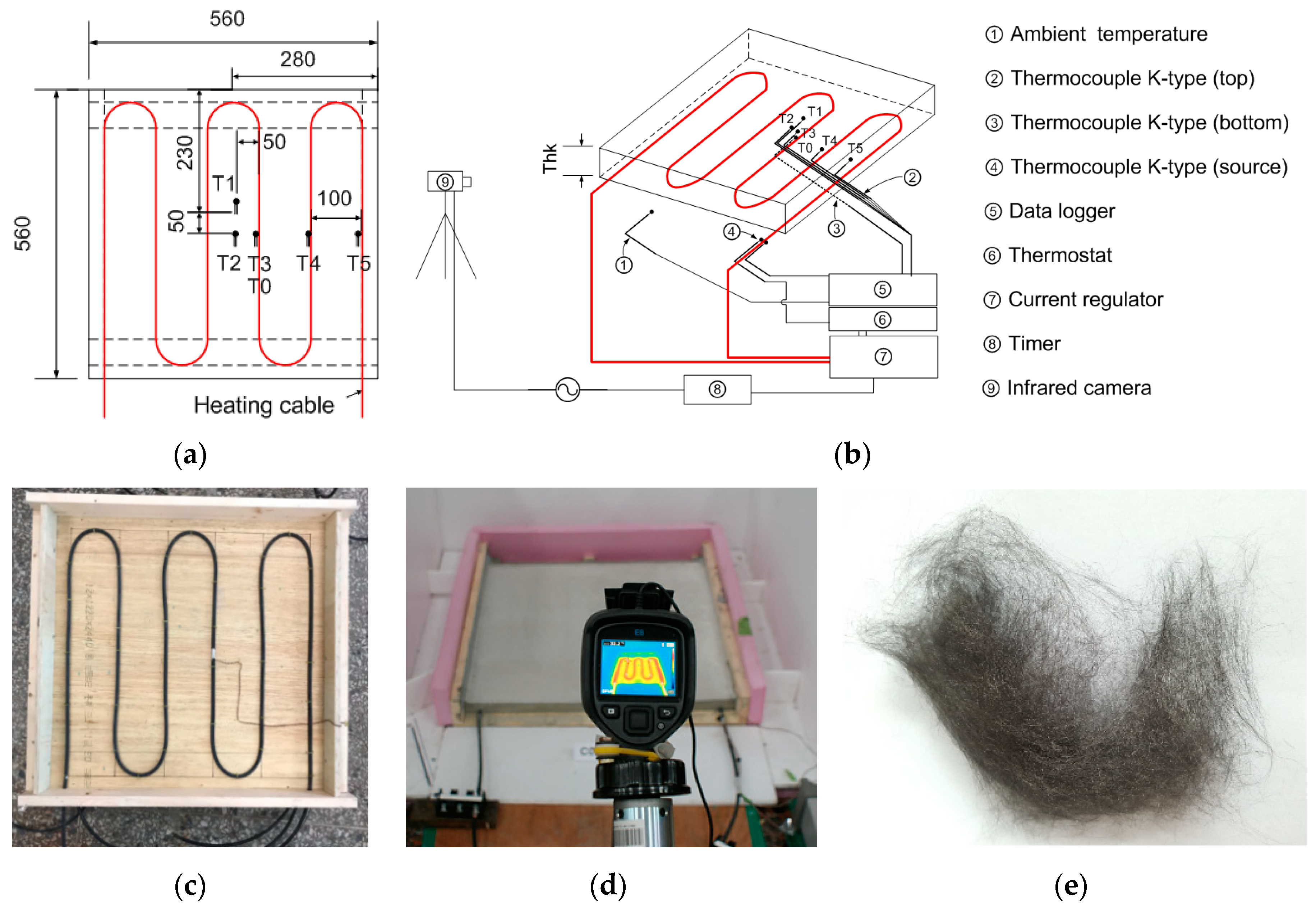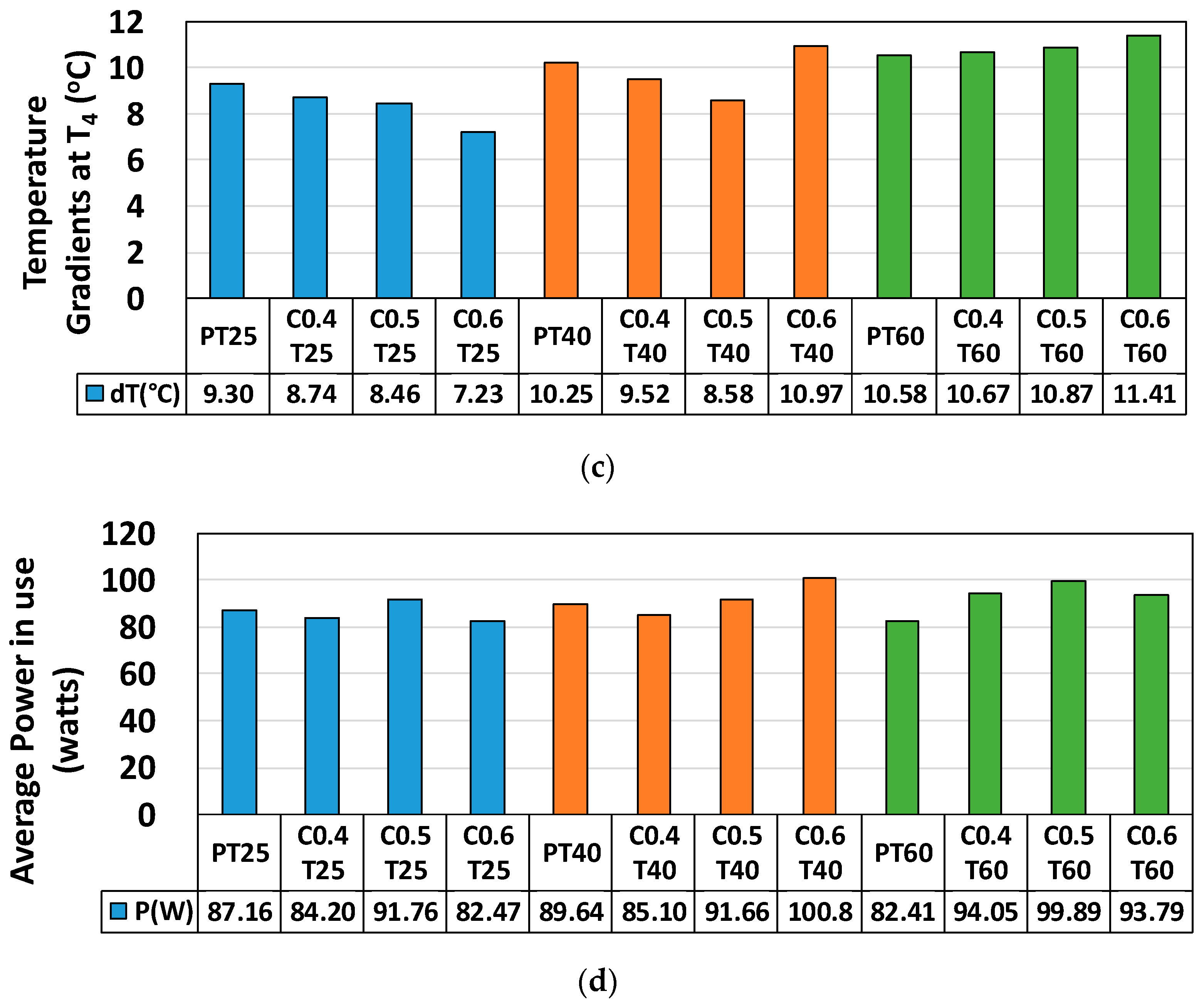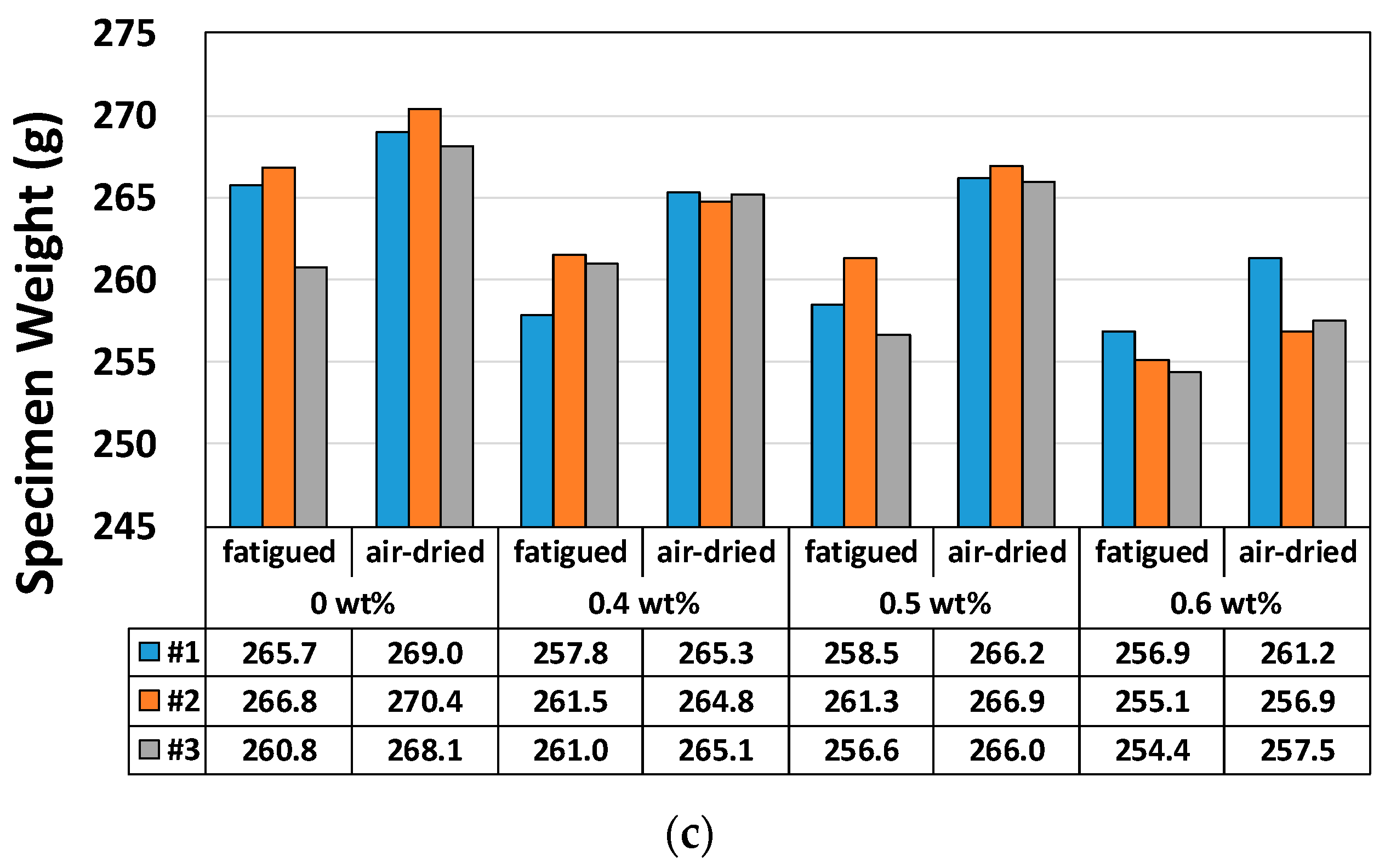Functional Properties of a Pitch-Based Carbon Fiber–Mortar Composite as a Thin Overlay for Concrete Pavement
Abstract
:1. Introduction
2. Materials and Methods
3. Results
4. Discussion and Conclusions
- (1)
- Thermal conductivity: The melt-blown pitch-based carbon fiber was characterized by low-strength individual fibers, but showed generally excellent thermal conductivity in tests of various mortar panels (0, 0.4, 0.5 or 0.6 wt % pitch-based carbon fiber content relative to the total weight of the cement, and thickness of 25, 40 or 60 mm). The absolute thermal conductivity tended to improve with a higher wt % of pitch-based carbon fiber in the range of 9~11 W/°C. However, the thermal conductivity tended to be lower under the 0.6 wt % condition, possibly due to the effect of dispersion.
- (2)
- Freeze-thaw resistance: Compressive strength degradation of 50 mm cube-shaped mortar specimens following 350 freeze-thaw cycles were measured at 91%, 89%, and 82% for the 0.4, 0.5, and 0.6 wt % samples, respectively, relative to the control specimen (0 wt %). Thus, all specimens had a strength of 80% or more after 350 cycles relative to the control specimen.
- (3)
- Adhesion performance: the adhesion performance of new and old concrete surfaces was tested. Concrete cylinders (100 mm × 200 mm; thickness = 10 mm) were cut at an angle of 46 degrees, and the pitch-based carbon fiber-mortar composite was used to bond the various sections. The bond strength of the test specimens was more than twice that of the reference specimen, although, at 0.6 wt %, the bond strength began to decline.
Author Contributions
Funding
Conflicts of Interest
References
- Chung, D.D.L. Materials for thermal conduction. Appl. Therm. Eng. 2001, 21, 1593–1605. [Google Scholar] [CrossRef]
- Chung, D.D.L. Electrical conduction behavior of cement-matrix composites. J. Mater. Eng. Perform. 2002, 11, 194–204. [Google Scholar] [CrossRef]
- Chung, D.D.L. Self-heating structural materials. Smart Mater. Struct. 2004, 13, 562–565. [Google Scholar] [CrossRef]
- Chung, D.D.L. Multifunctional Cement-Based Materials; Marcel Dekker Inc.: New York, NY, USA, 2004. [Google Scholar]
- Muthusamy, S.; Chung, D.D.L. Carbon-fiber cement-based materials for electromagnetic shielding. ACI Mater. J. 2010, 107, 603. [Google Scholar]
- Rhee, I.; Kim, J.H.; Park, S.H.; Lee, S.; Ryu, B.R.; Kim, Y.A. Mechanical and electrical properties of cement paste incorporated with pitch-based carbon fiber. Carbon Lett. 2017, 23, 22–29. [Google Scholar]
- Chang, C.; Ho, M.; Song, G.; Mo, Y.L.; Li, H. A feasibility study of self-heating concrete utilizing carbon nanofiber heating elements. Smart Mater. Struct. 2009, 18, 1–5. [Google Scholar] [CrossRef]
- Sanchez, F.; Ince, C. Microstructure and macroscopic properties of hybrid carbon nanofiber/silica fume cement composites. Compos. Sci. Technol. 2009, 69, 1310–1318. [Google Scholar] [CrossRef]
- Galao, O.; Zornoza, E.; Baeza, F.J.; Bernabeu, A.; Garcés, P. Effect of carbon nanofiber addition in the mechanical properties and durability of cementitious materials. Mater. Constr. 2012, 62, 343–357. [Google Scholar]
- Li, H.; Zhang, Q.; Xiao, H. Analytic investigations of CNFP-based self-deicing road system on the deicing performance. Cold Reg. Sci. Technol. 2014, 103, 123–132. [Google Scholar] [CrossRef]
- Galao, O.; Baeza, F.J.; Zornoza, E.; Garcés, P. Self-heating function of carbon nanofiber cement pastes. Mater. Constr. 2014, 64, 1–11. [Google Scholar]
- Zhang, Q.; Li, H. Experimental investigation on the ice/snow melting performance of CNFP & MWCNT/cement-based deicing system. In Proceedings of the 6th International Workshop on Advanced Smart Materials and Smart Structures Technology, Dalian, China, 25–26 July 2011. [Google Scholar]
- Li, H.; Zhang, Q.; Xiao, H. Self-deicing road system with a CNFP high-efficiency thermal source and MWCNT/cement-based high-thermal conductive composites. Cold Reg. Sci. Technol. 2013, 86, 22–35. [Google Scholar] [CrossRef]
- Chu, H.; Zhang, Z.; Liu, Y.; Leng, J. Self-heating fiber reinforced polymer composite using meso/macropore carbon nanotube paper and its application in deicing. Carbon 2014, 66, 154–163. [Google Scholar] [CrossRef]
- Kim, G.M.; Naeem, F.; Kim, H.K.; Lee, H.K. Heating and heat-dependent mechanical characteristics of CNT-embedded cementitious composites. Compos. Struct. 2016, 136, 162–170. [Google Scholar] [CrossRef]
- Rhee, I.; Lee, J.S.; Kim, Y.A.; Kim, J.H.; Kim, J.H. Electrically conductive cement mortar: Incorporating rice husk-derived high-surface area graphene. Constr. Build. Mater. 2016, 125, 632–642. [Google Scholar] [CrossRef]
- Wen, S.; Chung, D.L.L. Carbon fiber-reinforced cement as a thermistor. Cem. Concr. Res. 1999, 29, 961–965. [Google Scholar] [CrossRef]
- Baeza, F.J.; Galao, O.; Zornoza, E.; Garcés, P. Effect of aspect ratio on strain sensing capacity of carbon fiber reinforced cement composites. Mater. Des. 2013, 51, 1085–1094. [Google Scholar] [CrossRef]
- Tuan, C.; Yehia, S. Evaluation of electrically conductive concrete containing carbon products for deicing. ACI Mater. J. 2004, 101, 287–293. [Google Scholar]
- Lai, Y.; Liu, Y.; Ma, D. Automatically melting snow on airport cement concrete pavement with carbon fiber grille. Cold Reg. Sci. Technol. 2014, 103, 57–62. [Google Scholar] [CrossRef]
- Yu, W.B.; Yi, X.; Guo, M.; Chen, L. State of the art and practice of pavement anti-icing and de-icing techniques. Sci. Cold Arid Reg. 2014, 6, 14–21. [Google Scholar]
- Lai, J.; Qiu, J.; Chen, J.; Fan, H.; Wang, K. New Technology and experimental study on snow-melting heated pavement system in tunnel portal. Adv. Mater. Sci. Eng. 2015, 2015, 706536. [Google Scholar] [CrossRef]
- Wu, J.; Liu, J.; Yang, F. Three-phase composite conductive concrete for pavement deicing. Constr. Build. Mater. 2015, 75, 129–135. [Google Scholar] [CrossRef]
- Farnam, Y.; Todak, H.; Spragg, R.; Weiss, J. Electrical response of mortar with different degrees of saturation and deicing salt solutions during freezing and thawing. Cem. Concr. Compos. 2015, 59, 49–59. [Google Scholar] [CrossRef]
- Yehia, S.; Tuan, C. Conductive concrete overlay for bridge deck deicing. ACI Mater. J. 1999, 3, 382–390. [Google Scholar]
- Yehia, S.; Tuan, C.; Ferdon, D.; Chen, B. Conductive concrete overlay for bridge deck deicing: Mixture proportioning, optimization, and properties. ACI Mater. J. 2000, 2, 172–181. [Google Scholar]
- Urban, J.; Kleˇcka, T. Surface modification of fresh placed concrete and its durability at effect of defrosting substances. Adv. Mat. Res. 2014, 923, 138–141. [Google Scholar] [CrossRef]
- Liu, Z.; Hansen, W. Freezing characteristics of air-entrained concrete in the presence of deicing salt. Cem. Concr. Res. 2015, 74, 10–18. [Google Scholar] [CrossRef]
- Chen, P.W.; Chung, D.D.L. Comparative study of concretes reinforced with carbon, polyethylene, and steel fibers and their improvement by latex addition. ACI Mater. J. 1996, 93, 129. [Google Scholar]
- Chen, P.W.; Fu, X.; Chung, D.D.L. Microstructural and mechanical effects of latex, methylcellulose, and silica fume on carbon fiber reinforced cement. ACI Mater. J. 1997, 94, 147. [Google Scholar]
- Xu, Y.; Chung, D.D.L. Silane-treated carbon fiber for reinforcing cement. Carbon 2001, 39, 1995. [Google Scholar] [CrossRef]
- Baeza, F.J.; Chung, D.D.L.; Zornoza, E.; Andion, L.G.; Garces, P. Triple percolation in concrete reinforced with carbon fiber. ACI Mater. J. 2010, 107, 396–402. [Google Scholar]
- Yakhlaf, M.; Safiuddin, M.; Soudki, K.A. Properties of freshly mixed carbon fibre reinforced self-consolidating concrete. Constr. Build. Mater. 2013, 46, 224–231. [Google Scholar] [CrossRef]
- Wang, Z.; Gao, J.; Ai, T.; Jiang, W.; Zhao, P. Quantitative evaluation of carbon fiber dispersion in cement based composites. Constr. Build. Mater. 2014, 68, 26–30. [Google Scholar] [CrossRef]
- Watanabe, F.; Korai, Y.; Mochida, I.; Nishimura, Y. Structure of meltblown mesophase pitch-based carbon fiber. Carbon 2000, 38, 741–747. [Google Scholar] [CrossRef]
- Huang, X. Fabrication and properties of carbon fibers. Materials 2009, 2, 2369–2403. [Google Scholar] [CrossRef]
- Tang, Z.; Li, Z.; Qian, J.; Wang, K. Experimental study on deicing performance of carbon fiber reinforced conductive concrete. J. Mater. Sci. Technol. 2005, 21, 113–117. [Google Scholar]
- Zhao, H.M.; Wu, Z.M.; Wang, S.G.; Zheng, J.J.; Che, G.J. Concrete pavement deicing with carbon fiber heating wires. Cold Reg. Sci. Technol. 2011, 65, 413–420. [Google Scholar] [CrossRef]
- Xu, J.C.; Sui, Y.; Li, L.; Diao, B. Experimental study on the electrothermal effect of concrete reinforced with hybrid carbon and steel fiber. Appl. Mech. Mater. 2014, 490–491, 94–98. [Google Scholar] [CrossRef]
- Wu, J.; Yang, F.; Liu, J. Carbon fiber heating wire for pavement deicing. J. Test. Eval. 2015, 43, 574–581. [Google Scholar] [CrossRef]
- Galao, O.; Bañón, L.; Baeza, F.; Carmona, J.; Garcés, P. Highly Conductive Carbon Fiber Reinforced Concrete for Icing Prevention and Curing. Materials 2016, 9, 281. [Google Scholar] [CrossRef]
- Logan, D.L. A First Course in the Finite Element Method; PWS-KENT: Boston, MA, USA, 1992; pp. 575–578. [Google Scholar]
- Mehta, P.K.; Monteiro, P.J.M. Concrete: Microstructure, Properties, and Materials; McGraw-Hill: New York, NY, USA, 2006; pp. 595–607. [Google Scholar]








| Physical/Mechanical Properties | Pitch-Based Carbon Fiber (GS-Caltex, Daejeon, Korea) | PAN-Based Carbon Fiber (T-300; Toray,Tokyo, Japan) |
|---|---|---|
| Fiber diameter | 11.96 ± 5.24 μm | 7.11 ± 2 μm |
| Tensile strength | 0.35 ± 0.13 GPa | 3.55 ± 0.56 GPa |
| Tensile modulus | 25.89 ± 5.68 GPa | 228.52 ± 7.67 GPa |
| Elongation at break | 1.5 ± 0.58% | 1.69 ± 0.23% |
| Electrical conductivity | 2.2 × 102 S/cm | 5.88 × 102 S/cm |
| Specific gravity | 1.543 g/cm3 | 1.76 g/cm3 |
| Specimen | CF (g) | C (g) | W (g) | S (g) | SL (g) | SP (mL) | VA (g) | Geometry | |
|---|---|---|---|---|---|---|---|---|---|
| P | 0 | 720 | 360 | 576 | 216 | 2.8 | 0.4 | Cube (6 each) | |
| C0.4 | 2.9 | ||||||||
| C0.5 | 3.6 | ||||||||
| C0.6 | 4.3 | ||||||||
| P | T25 | 0 | 7526 | 3763 | 6021 | 2258 | 28.9 | 3.8 | Panel (12 each) |
| C0.4 | 30.1 | ||||||||
| C0.5 | 37.6 | ||||||||
| C0.6 | 45.2 | ||||||||
| P | T40 | 0 | 12,042 | 6021 | 9634 | 3613 | 46.2 | 6 | |
| C0.4 | 48.2 | ||||||||
| C0.5 | 60.2 | ||||||||
| C0.6 | 72.3 | ||||||||
| P | T60 | 0 | 18,063 | 9032 | 14,451 | 5419 | 69.2 | 9 | |
| C0.4 | 72.3 | ||||||||
| C0.5 | 90.3 | ||||||||
| C0.6 | 108.4 | ||||||||
| Specimen | P (W) | ΔT (°C) | k (W/m °C) | ka (W/°C) |
|---|---|---|---|---|
| PT25 | 87.2 | 9.3 | 0.597 | 9.372 |
| PT40 | 89.6 | 10.3 | 1.115 | 8.744 |
| PT60 | 82.4 | 10.6 | 1.490 | 7.790 |
| C0.4T25 | 84.2 | 8.7 | 0.614 | 9.634 |
| C0.4T40 | 85.1 | 9.5 | 1.140 | 8.941 |
| C0.4T60 | 94.1 | 10.7 | 1.686 | 8.812 |
| C0.5T25 | 91.8 | 8.5 | 0.692 | 10.843 |
| C0.5T40 | 91.7 | 8.6 | 1.363 | 10.683 |
| C0.5T60 | 99.9 | 10.9 | 1.758 | 9.186 |
| C0.6T25 | 82.5 | 7.2 | 0.728 | 11.408 |
| C0.6T40 | 100.8 | 11 | 1.172 | 9.190 |
| C0.6T60 | 93.8 | 11.4 | 1.573 | 8.222 |
| Specimen | k (W/m °C) | kMatlab (W/m °C) | hMatlab (W/m2 °C) |
|---|---|---|---|
| PT25 | 0.597 | 0.560 | 18 |
| PT40 | 1.115 | 1.120 | 18 |
| PT60 | 1.490 | 1.700 | 18 |
| C0.4T25 | 0.614 | 0.800 | 12 |
| C0.4T40 | 1.140 | 1.140 | 12 |
| C0.4T60 | 1.686 | 1.620 | 12 |
| C0.5T25 | 0.692 | 0.800 | 12 |
| C0.5T40 | 1.363 | 1.363 | 12 |
| C0.5T60 | 1.758 | 1.758 | 12 |
| C0.6T25 | 0.728 | 0.728 | 8 |
| C0.6T40 | 1.172 | 1.100 | 12 |
| C0.6T60 | 1.573 | 1.573 | 12 |
© 2019 by the authors. Licensee MDPI, Basel, Switzerland. This article is an open access article distributed under the terms and conditions of the Creative Commons Attribution (CC BY) license (http://creativecommons.org/licenses/by/4.0/).
Share and Cite
Lee, J.S.; Rhee, I. Functional Properties of a Pitch-Based Carbon Fiber–Mortar Composite as a Thin Overlay for Concrete Pavement. Materials 2019, 12, 2753. https://doi.org/10.3390/ma12172753
Lee JS, Rhee I. Functional Properties of a Pitch-Based Carbon Fiber–Mortar Composite as a Thin Overlay for Concrete Pavement. Materials. 2019; 12(17):2753. https://doi.org/10.3390/ma12172753
Chicago/Turabian StyleLee, Jun Seok, and Inkyu Rhee. 2019. "Functional Properties of a Pitch-Based Carbon Fiber–Mortar Composite as a Thin Overlay for Concrete Pavement" Materials 12, no. 17: 2753. https://doi.org/10.3390/ma12172753





